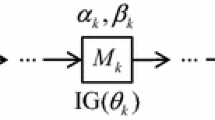Abstract
Conventional approaches to layout design of block stacked warehouses assume perfect staggering of product inflow leading to perfect sharing of space among products. Since such an assumption is seldom true, we argue that warehouses designed using the conventional approach may result in choking situations with large quantities of inventory waiting outside the storage areas. On the other hand, liberal space allocation such as in dedicated policy might lead to under-utilization of space. In this paper, we take a fresh look at the block stacked layout problem, modeling the effect of imperfectly staggered product arrivals using queuing theory. Analytical expressions are derived for arrival time and processing time coefficients of variation using warehouse parameters and design variables. Further, we develop a bi-objective optimization model to minimize both the space cost and waiting time. Our approach provides design options over a total space cost-waiting time trade-off frontier as opposed to singular design points given by conventional approaches. Computational experiments are conducted to derive further insights into the design of block stacked warehouses.











Similar content being viewed by others
References
Ashayeri J, Gelders LF (1985) Warehouse design optimization. Eur J Oper Res 21(3):285–294
Bartholdi JJ, Hackman ST (2011) Warehouse & distribution science: release 0.92. The Supply Chain and Logistics Institute, School of Industrial and Systems Engineering, Georgia Institute of Technology, Atlanta GA
Bassan Y, Roll Y, Rosenblatt MJ (1980) Internal layout design of a warehouse. AIIE Transactions 12(4):317–322
Breuer L (2010) The G/G/s Queue. Wiley encyclopedia of operations research and management science. Wiley, New York
Berry JR (1968) Elements of warehouse layout. Int J Prod Res 7(2):105–121
Das I, Dennis JE (1998) Normal-boundary intersection: A new method for generating the Pareto surface in nonlinear multicriteria optimization problems. SIAM J Optim 8(3):631–657
De Koster R, Le-Duc T, Roodbergen KJ (2007) Design and control of warehouse order picking: a literature review. Eur J Oper Res 182(2):481–501
Derhami S, Smith JS, Gue KR (2017) Optimising space utilisation in block stacking warehouses. Int J Prod Res 55(21):6436–6452
Derhami S, Smith JS, Gue KR (2019a) Space-efficient layouts for block stacking warehouses. IISE Trans 51:951–971
Derhami S, Smith JS, Gue KR (2019b) A simulation-based optimization approach to design optimal layouts for block stacking warehouses. Int J Prod Econ. https://doi.org/10.1016/j.ijpe.2019.107525
Goetschalckx M (2012) Storage systems and policies. In: Goetschalckx M (ed) Warehousing in the global supply chain. Springer, London, pp 31–51
Goetschalckx M, Ratldff HD (1991) Optimal lane depths for single and multiple products in block stacking storage systems. IIE Trans 23(3):245–258
Gray AE, Karmarkar US, Seidmann A (1992) Design and operation of an order-consolidation warehouse: models and application. Eur J Oper Res 58(1):14–36
Gu J, Goetschalckx M, McGinnis LF (2010) Research on warehouse design and performance evaluation: a comprehensive review. Eur J Oper Res 203(3):539–549
Hausman WH, Schwarz LB, Graves SC (1976) Optimal storage assignment in automatic warehousing systems. Manage Sci 22(6):629–638
Hopp WJ, Spearman ML (2011) Factory physics. Waveland Press, Long Grave
Kim IY, De Weck OL (2006) Adaptive weighted sum method for multiobjective optimization: a new method for Pareto front generation. Struct Multidiscip Optim 31(2):105–116
Kind DA (1975) Elements of space utilization. Transp Distrib Manag 15(2):29–34
Kind DA (1965) Measuring warehouse space utilization. Transp Distrib Manag 5(7):23–33
Kingman JFC (1961) The single server queue in heavy traffic. Math Proc Camb Philos Soc 57(04):902–904
Koski J (1985) Defectiveness of weighting method in multicriterion optimization of structures. Commun Appl Numer Methods 1(6):333–337
Marsh WH (1979) Elements of block storage design. Int J Prod Res 17(4):377–394
Matson JO, Sonnentag JJ, White JA Imhoff RC (2014) An analysis of block stacking with lot splitting. In: IIE Annual Conference. Proceedings. Institute of Industrial and Systems Engineers (IISE), p. 497
Matson JO White JA (1981) Storage system optimization. No. PDRC-81–09.Georgia Inst of Tech Atlanta Production and Distribution Research Center
Mattson CA, Messac A (2003) Concept selection using s-Pareto frontiers. AIAA J 41(6):1190–1198
Medhi J (1991) Stochastic models in queueing theory. Academic Press, San Diego
Rouwenhorst B, Reuter B, Stockrahm V, Van Houtum GJ, Mantel RJ, Zijm WHM (2000) Warehouse design and control: Framework and literature review. Eur J Oper Res 122(3):515–533
Stadler W (1979) A survey of multicriteria optimization or the vector maximum problem, part I: 1776–1960. J Optim Theory Appl 29(1):1–52
White JA, Francis RL (1971) Normative models for some warehouse sizing problems. AIIE Trans 3(3):185–190
Yu Y, Koster R, Guo X (2015) Class-based storage with a finite number of items: using more classes is not always better. Prod Oper Manag 24(8):1235–1247
Zadeh L (1963) Optimality and non-scalar-valued performance criteria. IEEE Trans Autom Control 8(1):59–60
Author information
Authors and Affiliations
Corresponding author
Additional information
Publisher's Note
Springer Nature remains neutral with regard to jurisdictional claims in published maps and institutional affiliations.
Rights and permissions
About this article
Cite this article
Venkitasubramony, R., Adil, G.K. Modeling the effect of imperfect staggering in product inflow using queuing theory: revisiting block stacking layout. Flex Serv Manuf J 33, 689–716 (2021). https://doi.org/10.1007/s10696-020-09390-8
Published:
Issue Date:
DOI: https://doi.org/10.1007/s10696-020-09390-8




